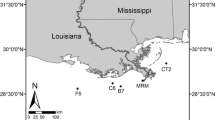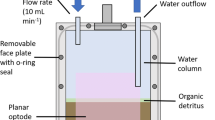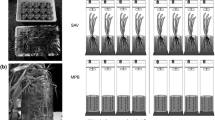Abstract
Seagrass beds are vulnerable to eutrophication (nutrient loading) and declining worldwide. To quantify the fate of nitrogen (N) inputs, intact sediment cores were incubated in a continuous-flow system with 15N enrichments to compare N consumption and efflux pathways within and near seagrass (Thalassia testudinum) beds in St. Joseph Bay, Florida. Sediment oxygen demand and total ammonium (NH4+) efflux were greater (p < 0.001) in vegetated versus unvegetated sediments, suggesting that seagrasses enhance organic matter remineralization. Denitrification rates were 2–20× greater than estimates of potential dissimilatory nitrate reduction to ammonium (DNRA). The effect of vegetation on denitrification rates was inconsistent. Direct denitrification of overlying water nitrate and N fixation rates were low, suggesting tight coupling between remineralization, nitrification, and denitrification. DNRA rates were lower than denitrification and consistently greater in vegetated sediments. DNRA rate measurements are conservative if sediment cation exchange decreases the fraction of 15NH4+ reaching overlying water, especially in vegetated sediments, where rates of nitrate-induced ammonium fluxes were observed. Coupled nitrification-denitrification was the major N loss pathway in this system, as evidenced by the lack of 15N-labeled N2 production in isotope-enriched cores. Using measured sediment oxygen demand and NH4+ fluxes as an indicator of organic matter quality and quantity, these results are consistent with previous work showing that labile organic matter helps regulate the balance between N removal and internal recycling pathways in seagrass systems, which has implications for coastal management strategies to address eutrophication.





Similar content being viewed by others
References
An, S., and W.S. Gardner. 2002. Dissimilatory nitrate reduction to ammonium (DNRA) as a nitrogen link, versus denitrification as a sink in a shallow estuary (Laguna Madre/Baffin Bay, Texas). Marine Ecology Progress Series 237: 41–50.
An, S., and S.B. Joye. 2001. Enhancement of coupled nitrification-denitrification by benthic photosynthesis in shallow estuarine sediments. Limnology and Oceanography 46 (1): 62–74.
An, S., W.S. Gardner, and T. Kana. 2001. Simultaneous measurement of denitrification and nitrogen fixation using isotope pairing with membrane inlet mass spectrometry analysis. Applied and Environmental Microbiology 67 (3): 1171–1178.
Aoki, L.R., and K.J. McGlathery. 2017. Push-pull incubation method reveals the importance of denitrification and dissimilatory nitrate reduction to ammonium in seagrass root zone. Limnology and Oceanography: Methods 15 (9): 766–781.
Beck, M.W., K.L. Heck Jp, K.W. Able, D.L. Childers, D.B. Eggleston, B.M. Gillanders, B. Halpern, C.G. Hays, K. Hoshino, T.J. Minello, R.J. Orth, P.F. Sheridan, and M.P. Weinstein. 2001. The identification, conservation, and management of estuarine and marine nurseries for fish and invertebrates. BioScience 51 (8): 633–641.
Bentzon-Tilia, M., S.J. Traving, M. Mantikci, H. Knudsen-Leerbeck, J.L. Hansen, S. Markager, and L. Riemann. 2015. Significant N 2 fixation by heterotrophs, photoheterotrophs and heterocystous cyanobacteria in two temperate estuaries. The ISME Journal 9 (2): 273–285.
Bollmann, A., G.S. Bullerjahn, and R.M. McKay. 2014. Abundance and diversity of ammonia-oxidizing archaea and bacteria in sediments of trophic end members of the Laurentian Great Lakes, Erie and Superior. PLoS One 9 (5): e97068.
Bourke, M.F., A.J. Kessler, and P.L. Cook. 2014. Influence of buried Ulva lactuca on denitrification in permeable sediments. Marine Ecology Progress Series 498: 85–94.
Braker, G., A. Fesefeldt, and K.P. Witzel. 1998. Development of PCR primer systems for amplification of nitrite reductase genes (nirK and nirS) to detect denitrifying bacteria in environmental samples. Applied and Environmental Microbiology 64 (10): 3769–3775.
Burgin, A.J., and S.K. Hamilton. 2007. Have we overemphasized the role of denitrification in aquatic ecosystems? A review of nitrate removal pathways. Frontiers in Ecology and the Environment 5 (2): 89–96.
Canfield, D. E., A. N. Glazer, and, P. G. Falkowski. 2010. The evolution and future of Earth’s nitrogen cycle. Science 330 (6001): 192–196.
Capone, D.G., and E.J. Carpenter. 1982. Nitrogen fixation in the marine environment. Science 217 (4565): 1140–1142.
Carlson, P.R., Jr., L.A. Yarbro, and T.R. Barber. 1994. Relationship of sediment sulfide to mortality of Thalassia testudinum in Florida Bay. Bulletin of Marine Science 54 (3): 733–746.
Christensen, J. P., J. W. Murray, A. H. Devol, and, L. A. Codispoti. 1987. Denitrification in continental shelf sediments has major impact on the oceanic nitrogen budget. Global Biogeochemical Cycles 1 (2): 97–116.
Cornwell, J.C., W.M. Kemp, and T.M. Kana. 1999. Denitrification in coastal ecosystems: methods, environmental controls, and ecosystem level controls, a review. Aquatic Ecology 33 (1): 41–54.
Dalsgaard, T., B. Thamdrup, and D.E. Canfield. 2005. Anaerobic ammonium oxidation (anammox) in the marine environment. Research in Microbiology 156 (4): 457–464.
Devol, A.H. 2015. Denitrification, anammox, and N2 production in marine sediments. Annual Review of Marine Science 7 (1): 403–423.
Duarte, C.M., and C.L. Chiscano. 1999. Seagrass biomass and production: a reassessment. Aquatic Botany 65 (1-4): 159–174.
Eyre, B.D., and A.J. Ferguson. 2009. Denitrification efficiency for defining critical loads of carbon in shallow coastal ecosystems. Hydrobiologia 629 (1): 137–146.
Eyre, B.D., S. Rysgaard, T. Dalsgaard, and P.B. Christensen. 2002. Comparison of isotope pairing and N2: Ar methods for measuring sediment denitrification—assumption, modifications, and implications. Estuaries 25 (6): 1077–1087.
Eyre, B.D., D. Maher, J.M. Oakes, D.V. Erler, and T.M. Glasby. 2011. Differences in benthic metabolism, nutrient fluxes, and denitrification in Caulerpa taxifolia communities compared to uninvaded bare sediment and seagrass (Zostera capricorni) habitats. Limnology and Oceanography 56 (5): 1737–1750.
Eyre, B.D., D.T. Maher, and P. Squire. 2013. Quantity and quality of organic matter (detritus) drives N2 effluxes (net denitrification) across seasons, benthic habitats, and estuaries. Global Biogeochemical Cycles 27 (4): 1083–1095.
Florida Department of Environmental Protection (FDEP) Coastal and Aquatic Managed Areas (CAMA) Program. September 2008. St. Joseph Bay Aquatic Preserve management plan, September, 2008–August, 2018. (Rev. ed.).
Florida Department of Environmental Protection (FDEP) Division of Environmental Assessment and Restoration Standards and Assessments Section. October 2012. Site-specific information in support of establishing numeric nutrient criteria for St. Joseph, Bay.
Francis, C.A., K.J. Roberts, J.M. Beman, A.E. Santoro, and B.B. Oakley. 2005. Ubiquity and diversity of ammonia-oxidizing archaea in water columns and sediments of the ocean. Proceedings of the National Academy of Sciences 102 (41): 14683–14688.
Friedrich, S., F. Konietschke, and M Pauly. 2016. MANOVA.RM: analysis of multivariate data and repeated measures designs. R package version 0.0.4. https://CRAN.R- project.org/package=MANOV A.RM.
Friedrich, S., E. Brunner, and M. Pauly. 2017. Permuting longitudinal data in spite of the dependencies. Journal of Multivariate Analysis 153: 255–265.
Fulweiler, R.W., S.M. Brown, S.W. Nixon, and B.D. Jenkins. 2013. Evidence and a conceptual model for the co-occurrence of nitrogen fixation and denitrification in heterotrophic marine sediments. Marine Ecology Progress Series 482: 57–68.
Galloway, J.N., A.R. Townsend, J.W. Erisman, M. Bekunda, Z. Cai, J.R. Freney, L.A. Martinelli, S.P. Seitzinger, and M.A. Sutton. 2008. Transformation of the nitrogen cycle: recent trends, questions, and potential solutions. Science 320 (5878): 889–892.
Garcias-Bonet, N., M. Fusi, M. Ali, D.R. Shaw, P.E. Saikaly, D. Daffonchio, and C.M. Duarte. 2018. High denitrification and anaerobic ammonium oxidation contributes to net nitrogen loss in a seagrass ecosystem in the central Red Sea. Biogeosciences 15 (23): 7333–7346.
Gardner, W., and M.J. McCarthy. 2009. Nitrogen dynamics at the sediment-water interface in shallow, sub-tropical Florida Bay: why denitrification efficiency may decrease with increased eutrophication. Biogeochemistry 95 (2-3): 185–198.
Gardner, W.S., S.P. Seitzinger, and J.M. Malczyk. 1991. The effects of sea salts on the forms of nitrogen released from estuarine and freshwater sediments: does ion pairing affect ammonium flux? Estuaries 14 (2): 157–166.
Gardner, W.S., H.A. Bootsma, C. Evans, and, P.A.S. John. 1995. Improved chromatographic analysis of 15N: 14N ratios in ammonium or nitrate for isotope addition experiments. Marine Chemistry 48 (3–4): 271–282.
Gardner, W.S., M.J. McCarthy, S. An, D. Sobolev, K.S. Sell, and D. Brock. 2006. Nitrogen fixation and dissimilatory nitrate reduction to ammonium (DNRA) support nitrogen dynamics in Texas estuaries. Limnology and Oceanography 51 (1part2): 558–568.
Gihring, T.M., A. Canion, A. Riggs, M. Huettel, and J.E. Kostk. 2010. Denitrification in shallow, sublittoral Gulf of Mexico permeable sediments. Limnology and Oceanography 55 (1): 43–54.
Glud, R.N. 2008. Oxygen dynamics of marine sediments. Marine Biology Research 4 (4): 243–289.
Harrell Jr F.E. with contributions from C. Dupont and many others. (2018). Hmisc: Harrell Miscellaneous. R package version 4.1–1. https://CRAN.R-project.org/package=Hmisc
Heck, K.L., J. R. Pennock, J. F. Valentine, L. D. Coen, and S. A. Sklenar. 2000. Effects of nutrient enrichment and small predator density on seagrass ecosystems: An experimental assessment. Limnology and Oceanography 45 (5):1041–1057
Hemminga, M., and C.M. Duarte. 2000. Seagrass ecology. Cambridge: Cambridge University Press.
Kana, T.M., C. Darkangelo, M.D. Hunt, J.B. Oldham, G.E. Bennett, and J.C. Cornwell. 1994. Membrane inlet mass spectrometer for rapid high-precision determination of N2, O2, and Ar in environmental water samples. Analytical Chemistry 66 (23): 4166–4170.
Kana, T.M., M.B. Sullivan, J.C. Cornwell, and K.M. Groxzkowski. 1998. Denitrification in estuarine sediments determined by membrane inlet mass spectrometry. Limnology and Oceanography 43 (2): 334–339.
Kessler, A.J., K.L. Roberts, A. Bissett, and P.L. Cook. 2018. Biogeochemical controls on the relative importance of denitrification and dissimilatory nitrate reduction to ammonium in estuaries. Global Biogeochemical Cycles 32 (7): 1045–1057. https://doi.org/10.1029/2018GB005908.
Koch, M.S., and J.M. Erskine. 2001. Sulfide as a phytotoxin to the tropical seagrass Thalassia testudinum: interactions with light, salinity and temperature. Journal of Experimental Marine Biology and Ecology 266 (1): 81–95.
Kuypers, M.M., H.K. Marchant, and B. Kartal. 2018. The microbial nitrogen-cycling network. Nature Reviews Microbiology 16 (5): 263–276.
Laursen, A.E., and S.P. Seitzinger. 2002. The role of denitrification in nitrogen removal and carbon mineralization in Mid-Atlantic Bight sediments. Continental Shelf Research 22 (9): 1397–1416.
Lavrentyev, P.J., W.S. Gardner, and L. Yang. 2000. Effects of the zebra mussel on nitrogen dynamics and the microbial community at the sediment-water interface. Aquatic Microbial Ecology 21 (2): 187–194.
Lee, K.S., and K.H. Dunton. 2000. Diurnal changes in pore water sulfide concentrations in the seagrass Thalassia testudinum beds: the effects of seagrasses on sulfide dynamics. Journal of Experimental Marine Biology and Ecology 255 (2): 201–214.
Marchant, H.K., M. Holtappels, G. Lavik, S. Ahmerkamp, C. Winter, and M.M. Kuypers. 2016. Coupled nitrification–denitrification leads to extensive N loss in subtidal permeable sediments. Limnology and Oceanography 61 (3): 1033–1048.
McCarthy, M.J., S.E. Newell, S.A. Carini, and W.S. Gardner. 2015. Denitrification dominates sediment nitrogen removal and is enhanced by bottom-water hypoxia in the Northern Gulf of Mexico. Estuaries and Coasts 38 (6): 2279–2294.
McCarthy, M.J., W.S. Gardner, M.F. Lehmann, A. Guindon, and D.F. Bird. 2016. Benthic nitrogen regeneration, fixation, and denitrification in a temperate, eutrophic lake: effects on the nitrogen budget and cyanobacteria blooms. Limnology and Oceanography 61 (4): 1406–1423.
Middelburg, J.J., K. Soetaert, P.M. Herman, and C.H. Heip. 1996. Denitrification in marine sediments: a model study. Global Biogeochemical Cycles 10 (4): 661–673.
Mulder, A., A.A. Van de Graaf, L.A. Robertson, and J.G. Kuenen. 1995. Anaerobic ammonium oxidation discovered in a denitrifying fluidized bed reactor. FEMS Microbiology Ecology 16 (3): 177–183.
Newell, S.E., K.R. Pritchard, S.Q. Foster, and R.W. Fulweiler. 2016. Molecular evidence for sediment nitrogen fixation in a temperate New England estuary. PeerJ 4: e1615.
Nielsen, L.P. 1992. Denitrification in sediment determined from nitrogen isotope pairing. FEMS Microbiology Letters 86 (4): 357–362.
Orth, R.J., T.J.B. Carruthers, W.C. Dennison, C.M. Duarte, J.W. Fourqurean, K.L. Heck Jr., A.R. Hughes, G.A. Kendrick, W.J. Kenworthy, S. Olyarnik, F.T. Short, M. Waycott, and S.L. Williams. 2006. A global crisis for seagrass ecosystems. BioScience 56 (12): 987–995.
Poly, F., L. Ranjard, S. Nazaret, F. Gourbière, and L.J. Monrozier. 2001. Comparison of nifH gene pools in soils and soil microenvironments with contrasting properties. Applied and Environmental Microbiology 67 (5): 2255–2262.
Rao, A.M., M.J. McCarthy, W.S. Gardner, and R.A. Jahnke. 2007. Respiration and denitrification in permeable continental shelf deposits on the South Atlantic Bight: Rates of carbon and nitrogen cycling from sediment column experiments. Continental Shelf Research 27 (13): 1801–1819.
Rao, A.M., M.J. McCarthy, W.S. Gardner, and R.A. Jahnke. 2008. Respiration and denitrification in permeable continental shelf deposits on the South Atlantic Bight: N2: Ar and isotope pairing measurements in sediment column experiments. Continental Shelf Research 28 (4–5): 602–613.
Robertson, E.K., M. Bartoli, V. Brüchert, T. Dalsgaard, P.O. Hall, D. Hellemann, S. Hietanen, M. Zilius, and D.J. Conley. 2019. Application of the isotope pairing technique in sediments: use, challenges, and new directions. Limnology and Oceanography: Methods. 17 (2): 112–136. https://doi.org/10.1002/lom3.10303.
Rotthauwe, J.H., K.P. Witzel, and W. Liesack. 1997. The ammonia monooxygenase structural gene amoA as a functional marker: molecular fine-scale analysis of natural ammonia-oxidizing populations. Applied and Environmental Microbiology 63 (12): 4704–4712.
Rysgaard, S., R.N. Glud, N. Risgaard-Petersen, and T. Dalsgaard. 2004. Denitrification and anammox activity in Arctic marine sediments. Limnology and Oceanography 49 (5): 1493–1502.
Salk, K.R., D.V. Erler, B.D. Eyre, N. Carlson-Perret, and N.E. Ostrom. 2017. Unexpectedly high degree of anammox and DNRA in seagrass sediments: description and application of a revised isotope pairing technique. Geochimica et Cosmochimica Acta 211: 64–78.
Seiki, T., H. Izawa, E. Date, and H. Sunahara. 1994. Sediment oxygen demand in Hiroshima Bay. Water Research 28 (2): 385–393.
Seitzinger, S.P. 1988. Denitrification in freshwater and coastal marine ecosystems: ecological and geochemical significance. Limnololgy and Oceanography 33: 702–724.
Seitzinger, S.P., W.S. Gardner, and A.K. Spratt. 1991. The effect of salinity on ammonium sorption in aquatic sediments: implications for benthic nutrient recycling. Estuaries 14 (2): 167–174.
Short, F.T., and S. Wyllie-Echeverria. 1996. Natural and human-induced disturbance of seagrasses. Environmental Conservation 23 (1): 17–27.
Steingruber, S.M., J. Friedrich, R. Gächter, and B. Wehrli. 2001. Measurement of denitrification in sediments with the 15N isotope pairing technique. Applied and Environmental Microbiology 67 (9): 3771–3778.
Strope, E. 2018. Effects of drift macroalgae on sediment nitrogen cycling in Thalassia testudinum beds of St. Joseph Bay, FL. Master of Science in Integrative Biology Theses 33. https://digitalcommons.kennesaw.edu/integrbiol_etd/33. Accessed 26 July 2018.
Throbäck, I.N., K. Enwall, Å. Jarvis, and S. Hallin. 2004. Reassessing PCR primers targeting nirS, nirK and nosZ genes for community surveys of denitrifying bacteria with DGGE. FEMS Microbiology Ecology 49 (3): 401–417.
Tiedje, J.M. 1988. Ecology of denitrification and dissimilatory nitrate reduction to ammonium. Biology of Anaerobic Microorganisms 717: 179–244.
van Luijn, F., P.C. Boers, and L. Lijklema. 1996. Comparison of denitrification rates in lake sediments obtained by the N2 flux method, the 15N isotope pairing technique and the mass balance approach. Water Research 30 (4): 893–900.
Ward, B.B. 2008. Nitrification in marine systems. Nitrogen in the Marine Environment 2: 199–261.
Ward, B.B., A.H. Devol, J.J. Rich, B.X. Chang, S.E. Bulow, H. Naik, A. Pratihary, and A. Jayakumar. 2009. Denitrification as the dominant nitrogen loss process in the Arabian Sea. Nature 461 (7260): 78–81.
Waycott, M., C.M. Duarte, T.J. Carruthers, R.J. Orth, W.C. Dennison, S. Olyarnik, A. Calladine, J.W. Fourqurean, K.L. Heck, A.R. Hughes, and G.A. Kendrick. 2009. Accelerating loss of seagrasses across the globe threatens coastal ecosystems. Proceedings of the National Academy of Sciences 106 (30): 12377–12381.
Welsh, A., J.C. Chee-Sanford, L.M. Connor, F.E. Löffler, and R.A. Sanford. 2014. Refined NrfA phylogeny improves PCR-based nrfA gene detection. Applied and Environmental Microbiology 80 (7): 2110–2119.
Acknowledgments
We thank the T.H. Stone Memorial State Park and the Florida Department of Environmental Protection for providing permits and access to sampling locations and Alex Lamle, Joseph Dirnberger, and Katie Horning for their assistance in 2014 sampling.
Funding
Funding for this research was provided by the College of Science and Math, Department of Ecology, Evolution, and Organismal Biology, and Center for Excellence in Teaching and Learning at Kennesaw State University. Additional financial support for Hoffman was provided by the Birla Carbon Scholar’s Program, the Graduate School at Wright State University, and Ohio Sea Grant during the preparation of this manuscript.
Author information
Authors and Affiliations
Corresponding author
Additional information
Communicated by Lijun Hou
Rights and permissions
About this article
Cite this article
Hoffman, D.K., McCarthy, M.J., Newell, S.E. et al. Relative Contributions of DNRA and Denitrification to Nitrate Reduction in Thalassia testudinum Seagrass Beds in Coastal Florida (USA). Estuaries and Coasts 42, 1001–1014 (2019). https://doi.org/10.1007/s12237-019-00540-2
Received:
Revised:
Accepted:
Published:
Issue Date:
DOI: https://doi.org/10.1007/s12237-019-00540-2




